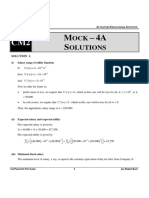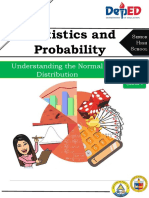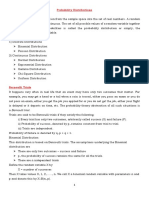Model For Quantifying Risks (Table of Content)
Uploaded by
Walter WongModel For Quantifying Risks (Table of Content)
Uploaded by
Walter WongTABLE OF CONTENTS
PREFACE iii PART ONE: REVIEW AND BACKGROUND MATERIAL CHAPTER ONE: REVIEW OF INTEREST THEORY 1.1 1.2 Interest Measures 3 Level Annuity Functions 5 1.2.1 Immediate Annuity 6 1.2.2 Annuity-due 6 1.2.3 Continuous Annuity 7 Non-Level Annuity Functions 8 1.3.1 Immediate Annuities 8 1.3.2 Annuities-due 10 1.3.3 Continuous Annuities 12 Equation of Value 13 3
1.3
1.4
CHAPTER TWO: REVIEW OF PROBABILITY 15 2.1 Random Variables and Their Distributions 15 2.1.1 Discrete Random Variables 15 2.1.2 Continuous Random Variables 18 2.1.3 Mixed Random Variables 19 2.1.4 More on Moments of Random Variables 19 Survey of Particular Discrete Distributions 21 2.2.1 The Discrete Uniform Distribution 21 2.2.2 The Binomial Distribution 21 2.2.3 The Negative Binomial Distribution 22 2.2.4 The Geometric Distribution 23 2.2.5 The Poisson Distribution 23 Survey of Particular Continuous Distributions 24 2.3.1 The Continuous Uniform Distribution 24 2.3.2 The Normal Distribution 25 2.3.3 The Exponential Distribution 26 2.3.4 The Gamma Distribution 27 Multivariate Probability 28 2.4.1 The Discrete Case 28 2.4.2 The Continuous Case 30
vii
2.2
2.3
2.4
viii TABLE OF CONTENTS
CHAPTER THREE: REVIEW OF MARKOV CHAINS 33 3.1 Discrete-Time Markov Chains 33 3.1.1 Transition Probabilities 34 3.1.2 State Vector 36 3.1.3 Probabilities over Multiple Steps 36 3.1.4 Properties of Homogeneous Discrete-Time Markov Chains 37 3.1.5 The Non-Homogeneous Discrete-Time Model 37 3.1.6 Probability of Remaining in State i 39 Continuous-Time Markov Chains 395 3.2.1 Forces of Transition 40 ( 3.2.2 Formulas for r = Pr[ X (t = j | X (t ) i ] 41 pijt ) +r) = Payments 43
3.2
3.3
CHAPTER FOUR: REVIEW OF STOCHASTIC SIMULATION 45 4.1 4.2 4.3 The Simulation Process 45 Multiplicative Congruential Random Number Generators 46 The Inversion Method for Generating Simulated Output Values from Continuous Distributions 47 4.3.1 The Exponential Distribution 48 4.3.2 The Pareto Distribution 49 4.3.3 Additional Continuous Distributions 49 The Table Look-Up Method for Discrete Probability Distributions 50 4.4.1 The Discrete Uniform Distribution 51 4.4.2 The Bernoulli Distribution 51 4.4.3 The Binomial Distribution 51 4.4.4 The Negative Binomial Distribution 52 4.4.5 The Poisson Distribution 53 4.4.6 Applications of the Material in Section 4.4 56 Methods for Generating Simulated Normal Distribution Values 56 4.5.1 The Polar Method 56 4.5.2 The Box-Muller Method 57
4.4
4.5
PART TWO: M ODELS FOR SURVIVAL -C ONTINGENT R ISKS CHAPTER FIVE: SURVIVAL MODELS (CONTINUOUS PARAMETRIC CONTEXT) 61 5.1 The Age-at-Failure Random Variable 61 5.1.1 The Cumulative Distribution Function of X 62 5.1.2 The Survival Distribution Function of X 62 5.1.3 The Probability Density Function of X 63 5.1.4 The Hazard Rate Function of X 64 5.1.5 The Moments of the Age-at-Failure Random Variable X 66 5.1.6 Actuarial Survival Models 66 Examples of Parametric Survival Models 67 5.2.1 The Uniform Distribution 67
5.2
TABLE OF CONTENTS ix
5.3
5.4 5.5 5.6
5.2.2 The Exponential Distribution 68 5.2.3 The Gompertz Distribution 69 5.2.4 The Makeham Distribution 69 5.2.5 Summary of Parametric Survival Models 70 The Time-to-Failure Random Variable 70 5.3.1 The Survival Distribution Function of Tx 71 5.3.2 The Cumulative Distribution Function of Tx 71 5.3.3 The Probability Density Function of Tx 72 5.3.4 The Hazard Rate Function of Tx 73 5.3.5 Moments of the Future Lifetime Random Variable Tx 73 5.3.6 Discrete Time-to-Failure Random Variables 75 Select Survival Models 77 Multi-State Model Interpretation 78 Exercises 81
CHAPTER SIX: THE LIFE TABLE (DISCRETE TABULAR CONTEXT) 85 6.1 6.2 6.3 Definition of the Life Table 85 The Traditional Form of the Life Table 86 Other Functions Derived from x 88 6.3.1 The Force of Failure 88 6.3.2 The Probability Density Function of X 89 6.3.3 Conditional Probabilities and Densities 91 6.3.4 The Curtate Expectation of Life 93 Summary of Concepts and Notation 95 Multi-State Model Interpretation 95 Methods for Non-Integral Ages 98 6.6.1 Linear Form for x +t 98 6.6.2 Exponential Form for x +t 101 6.6.3 Hyperbolic Form for x +t 102 6.6.4 Summary 104 Select Life Tables 104 Life Table Summary 107 Exercises 108
6.4 6.5 6.6
6.7 6.8 6.9
CHAPTER SEVEN: CONTINGENT PAYMENT MODELS (INSURANCE MODELS) 115 7.1 Discrete Stochastic Models 115 7.1.1 The Discrete Random Variable for Time of Failure 116 7.1.2 The Present Value Random Variable 116 7.1.3 Modifications of the Present Value Random Variable 118 7.1.4 Applications to Life Insurance 123 Group Deterministic Approach 126 Continuous Stochastic Models 128 7.3.1 The Continuous Random Variable for Time to Failure 128 7.3.2 The Present Value Random Variable 129 7.3.3 Modifications of the Present Value Random Variable 130 7.3.4 Applications to Life Insurance 130
7.2 7.3
x TABLE OF CONTENTS
7.4 7.5
7.6
7.7 7.8
7.3.5 Continuous Functions Evaluated from Parametric Survival Models 131 Contingent Payment Models with Varying Payments 133 Continuous and mthly Functions Approximated from the Life Table 135 7.5.1 Continuous Contingent Payment Models 135 7.5.2 mthly Contingent Payment Models 138 Multi-State Model Representation 139 7.6.1 Discrete Models 139 7.6.2 Continuous Models 140 7.6.3 Extension to Models with Varying Payments 141 Miscellaneous Examples 141 Exercises 144
CHAPTER EIGHT: CONTINGENT ANNUITY MODELS (LIFE ANNUITIES) 149 8.1 Whole Life Annuity Models 150 8.1.1 The Immediate Case 150 8.1.2 The Due Case 154 8.1.3 The Continuous Case 157 Temporary Annuity Models 158 8.2.1 The Immediate Case 158 8.2.2 The Due Case 161 8.2.3 The Continuous Case 164 Deferred Whole Life Annuity Models 166 8.3.1 The Immediate Case 166 8.3.2 The Due Case 168 8.3.3 The Continuous Case 168 Contingent Annuities Payable mthly 170 8.4.1 The Immediate Case 170 8.4.2 The Due Case 171 8.4.3 Random Variable Analysis 172 8.4.4 Numerical Evaluation in the mthly and Continuous Cases 173 Non-Level Payment Annuity Functions 176 Multi-State Model Representation 177 Miscellaneous Examples 179 Exercises 182
8.2
8.3
8.4
8.5 8.6 8.7 8.8
C HAPTER NINE: F UNDING P LANS FOR C ONTINGENT C ONTRACTS 189 (ANNUAL P REMIUMS) 9.1 Annual Funding Schemes for Contingent Payment Models 190 9.1.1 Discrete Contingent Payment Models 190 9.1.2 Continuous Contingent Payment Models 193 9.1.3 Contingent Annuity Models 194 9.1.4 Non-Level Premium Contracts 196 9.2 Random Variable Analysis 196 9.3 The Percentile Premium Principle 201 9.4 Continuous Payment Funding Schemes 203 9.4.1 Discrete Contingent Payment Models 203 9.4.2 Continuous Contingent Payment Models 204 9.5 Funding Schemes with mthly Payments 206
TABLE OF CONTENTS xi
9.6 9.7 9.8
Funding Plans Incorporating Expenses 208 Miscellaneous Examples 211 Exercises 213
CHAPTER TEN: CONTINGENT CONTRACT RESERVES (NET LEVEL PREMIUM BENEFIT RESERVES) 219 10.1 NLP Reserves for Contingent Payment Models with Annual Payment Funding 221 10.1.1 NLP Reserves by the Prospective Method 221 10.1.2 NLP Reserves by the Retrospective Method 223 10.1.3 Additional NLP Terminal Reserve Expressions 225 10.1.4 Random Variable Analysis 227 10.1.5 NLP Reserves for Contingent Contracts with Immediate Payment of Claims 228 10.1.6 NLP Reserves for Contingent Annuity Models 229 10.2 Recursive Relationships for Discrete Models with Annual Premiums 229 10.3 NLP Reserves for Contingent Payment Models with Continuous Payment Funding 233 10.3.1 Discrete Whole Life Contingent Payment Models 233 10.3.2 Continuous Whole Life Contingent Payment Models 233 10.3.3 Random Variable Analysis 236 10.4 NLP Reserves for Contingent Payment Models with mthly Payment Funding 237 10.5 Multi-State Model Representation 239 10.6 Miscellaneous Examples 239 10.7 Exercises 243 CHAPTER ELEVEN: CONTINGENT CONTRACT RESERVES (RESERVES AS FINANCIAL LIABILITIES) 247 11.1 Modified Benefit Reserves 248 11.1.1 Reserve Modification in General 249 11.1.2 Full Preliminary Term Modified Reserves 250 11.1.3 Deficiency Reserves 252 11.1.4 Negative Reserves 252 11.2 Benefit Reserves at Fractional Durations 252 11.3 Generalization to Non-Level Benefits and Benefit Premiums 254 11.3.1 Discrete Models 254 11.3.2 Continuous Models 256 11.4 Incorporation of Expenses 258 11.5 Introduction to Universal Life Insurance 260 11.5.1 Universal Life with Variable Failure Benefit 260 11.5.2 Universal Life with Fixed Failure Benefit 262 11.6 Introduction to Deferred Variable Annuities 263 11.7 Exercises 264
xii TABLE OF CONTENTS
CHAPTER TWELVE: MODELS DEPENDENT ON MULTIPLE SURVIVALS (MULTI-LIFE MODELS) 267 12.1 The Joint-Life Model 267 12.1.1 The Time-to-Failure Random Variable for a Joint-Life Status 267 12.1.2 The Survival Distribution Function of Txy 268 12.1.3 The Cumulative Distribution Function of Txy 268 12.1.4 The Probability Density Function of Txy 269 12.1.5 The Hazard Rate Function of Txy 270 12.1.6 Conditional Probabilities 270 12.1.7 Moments of Txy 271 12.2 The Last-Survivor Model 272 12.2.1 The Time-to-Failure Random Variable for a Last-Survivor Status 272 12.2.2 Functions of the Random Variable Txy 273 12.2.3 Relationships Between Txy and Txy 275 12.3 Contingent Probability Functions 276 12.4 Contingent Contracts Involving Multi-Life Statuses 278 12.4.1 Contingent Payment Models 278 12.4.2 Contingent Annuity Models 280 12.4.3 Annual Premiums and Reserves 280 12.4.4 Reversionary Annuities 282 12.4.5 Contingent Insurance Functions 283 12.5 Multi-State Model Representation 284 12.5.1 The General Model 284 12.5.2 The Joint-Life Model 285 12.5.3 Reversionary Annuities 286 12.5.4 Contingent Insurance Functions 287 12.5.5 The Last-Survivor Model 287 12.5.6 Solving the Kolmogorov Forward Equation 288 12.6 General Random Variable Analysis 289 12.6.1 Marginal Distributions of Tx and Ty 290 12.6.2 The Covariance of Tx and Ty 290 12.6.3 Other Joint Functions of Tx and Ty 292 12.6.4 Joint and Last-Survivor Status Functions 294 12.7 Common Shock A Model for Lifetime Dependency 295 12.8 Exercises 299 CHAPTER THIRTEEN: MULTIPLE-DECREMENT MODELS (THEORY) 303 13.1 Discrete Multiple-Decrement Models 303 13.1.1 The Multiple-Decrement Table 305 13.1.2 Random Variable Analysis 307 13.2 Theory of Competing Risks 308 13.3 Continuous Multiple-Decrement Models 309 13.4 Uniform Distribution of Decrements 313 13.4.1 Uniform Distribution in the Multiple-Decrement Context 313 13.4.2 Uniform Distribution in the Associated Single-Decrement Tables 13.5 Miscellaneous Examples 316 13.6 Exercises 317
315
TABLE OF CONTENTS xiii
CHAPTER FOURTEEN: MULTIPLE-DECREMENT MODELS (APPLICATIONS) 321 14.1 Actuarial Present Value 321 14.2 Asset Shares 325 14.3 Non-Forfeiture Options 328 14.3.1 Cash Values 328 14.3.2 Reduced Paid-Up Insurance 329 14.3.3 Extended Term Insurance 329 14.3.4 Application to Universal Life Insurance 330 14.3.5 Application to Deferred Variable Annuities 330 14.4 Multi-State Model Representation, with Illustrations 330 14.4.1 The General Multiple-Decrement Model 330 14.4.2 The Total and Permanent Disability Model 333 14.4.3 Disability Model Allowing for Recovery 337 14.4.4 Continuing Care Retirement Communities 343 14.4.5 Thieles Differential Equation in the Multiple-Decrement Case 344 14.5 Defined Benefit Pension Plans 349 14.5.1 Normal Retirement Benefits 349 14.5.2 Early Retirement Benefits 352 14.5.3 Withdrawal and Other Benefits 353 14.5.4 Funding and Reserving 354 14.6 Exercises 356 PART THREE: MODELS FOR INTEREST RATE RISKS C HAPTER F IFTEEN: M ODELS WITH VARIABLE I NTEREST R ATES 363 15.1 Actuarial Present Values Using Variable Interest Rates 363 15.2 Deterministic Interest Rate Scenarios 366 15.3 Spot Interest Rates and the Term Structure of Interest Rates 368 15.4 Forward Interest Rates 371 15.5 An Example with Simulated Rates of Return 375 15.6 Transferring the Interest Rate Risk 377 15.7 Exercises 378 CHAPTER SIXTEEN: UNIVERSAL LIFE INSURANCE 383 16.1 Basic Aspects 383 16.1.1 Policyholder Choice 383 16.1.2 Interest Rate Risk 384 16.1.3 Secondary Guarantees 385 16.2 Indexed Universal Life Insurance 386 16.3 Pricing Considerations 388 16.3.1 Mortality 388 16.3.2 Lapse 389 16.3.3 Expenses 390 16.3.4 Investment Income 391 16.3.5 Pricing for Secondary Guarantees 391
xiv TABLE OF CONTENTS
16.4 Reserving Considerations 392 16.4.1 Basic Universal Life 392 16.4.2 Variable Universal Life 395 16.4.3 Indexed Universal Life 395 16.4.4 Contracts with Secondary Guarantees 16.5 Exercises 399
397
CHAPTER SEVENTEEN: DEFERRED VARIABLE ANNUITIES 401 17.1 Background 401 17.2 Deferred Annuity Products 402 17.2.1 Fixed Deferred Annuity 402 17.2.2 Variable Deferred Annuity 404 17.2.3 Equity-Indexed Deferred Annuity 407 17.2.4 The Payout Phase of a Deferred Annuity 412 17.2.5 Guaranteed Minimum Death Benefit 413 17.2.6 Guaranteed Minimum Income Benefit 413 17.2.7 Miscellaneous Considerations 414 17.3 Immediate Annuity Products 415 17.3.1 Fixed Immediate Annuity 415 17.3.2 Variable Immediate Annuity 415 17.4 Pricing Considerations 417 17.4.1 Variable Deferred Annuity 417 17.4.2 Variable Immediate Annuity 417 17.5 Reserving Considerations 419 17.5.1 Deferred Annuity Reserve 419 17.5.2 Immediate Annuity Reserve 420 17.5.3 Reserving for a Guaranteed Death Benefit 420 17.5.4 Reserving for a Guaranteed Income Benefit 421 17.6 Exercises 421
APPENDIX A
USING MICROSOFT EXCEL AND VISUAL BASIC MACROS TO COMPUTE ACTUARIAL FUNCTIONS 425 SIMULATION ILLUSTRATIONS 439
APPENDIX B
ANSWERS TO THE EXERCISES 449 BIBLIOGRAPHY 467 INDEX 469
You might also like
- Quantitative Finance by Maria C. Mariani Ionut Florescu100% (6)Quantitative Finance by Maria C. Mariani Ionut Florescu491 pages
- (Thierfelder 15) - The Trending Ornstein Uhlenbeck Process and Its Applications in FinanceNo ratings yet(Thierfelder 15) - The Trending Ornstein Uhlenbeck Process and Its Applications in Finance93 pages
- Time Series Analysis: Nonstationary and Noninvertible Distribution TheoryFrom EverandTime Series Analysis: Nonstationary and Noninvertible Distribution TheoryNo ratings yet
- Aggregation of Correlated Risk Portfolios - Models and Algorithms PDFNo ratings yetAggregation of Correlated Risk Portfolios - Models and Algorithms PDF50 pages
- Institute of Actuaries of India: Subject ST6 - Finance and Investment BNo ratings yetInstitute of Actuaries of India: Subject ST6 - Finance and Investment B7 pages
- CS2 - Risk Modelling and Survival Analysis Core Principles: Syllabus0% (1)CS2 - Risk Modelling and Survival Analysis Core Principles: Syllabus8 pages
- Overview of Pricing Models: Module 5: Designing and Pricing An Actuarial SolutionNo ratings yetOverview of Pricing Models: Module 5: Designing and Pricing An Actuarial Solution3 pages
- Institute and Faculty (Ifoa) Exams Passed Waivers From Soa ExaminationNo ratings yetInstitute and Faculty (Ifoa) Exams Passed Waivers From Soa Examination1 page
- Book An Introduction To The Math of Financial Derivatives Neftci S.N. SOLUTIONNo ratings yetBook An Introduction To The Math of Financial Derivatives Neftci S.N. SOLUTION90 pages
- ST7 General Insurance Reserving&Capital ModelingNo ratings yetST7 General Insurance Reserving&Capital Modeling5 pages
- SPECIMEN EXAM PAPER - CM1B - IFoA - 2019 - Final 100mksNo ratings yetSPECIMEN EXAM PAPER - CM1B - IFoA - 2019 - Final 100mks3 pages
- Subject CS1 - Actuarial Statistics For 2022 Examinations: Institute of Actuaries of IndiaNo ratings yetSubject CS1 - Actuarial Statistics For 2022 Examinations: Institute of Actuaries of India6 pages
- Mike Karls - Modeling First Approach in Traditional ODE CourseNo ratings yetMike Karls - Modeling First Approach in Traditional ODE Course41 pages
- Risk and Financial Management: Mathematical and Computational MethodsFrom EverandRisk and Financial Management: Mathematical and Computational MethodsNo ratings yet
- Value at Risk, 3rd Ed.: The New Benchmark for Managing Financial RiskFrom EverandValue at Risk, 3rd Ed.: The New Benchmark for Managing Financial RiskNo ratings yet
- Solutions Manual to Accompany Introduction to Quantitative Methods in Business: with Applications Using Microsoft Office ExcelFrom EverandSolutions Manual to Accompany Introduction to Quantitative Methods in Business: with Applications Using Microsoft Office ExcelNo ratings yet
- Economic Dynamics in Discrete Time The MIT Press 2nd Edition Jianjun Miao instant download100% (1)Economic Dynamics in Discrete Time The MIT Press 2nd Edition Jianjun Miao instant download42 pages
- Chung-Ki Min - Applied Econometrics - A Practical Guide (Routledge Advanced Texts in Economics and Finance) - Routledge (2019)No ratings yetChung-Ki Min - Applied Econometrics - A Practical Guide (Routledge Advanced Texts in Economics and Finance) - Routledge (2019)313 pages
- Buy ebook An Introduction to Statistical Computing A Simulation based Approach 1st Edition Jochen Voss cheap price100% (8)Buy ebook An Introduction to Statistical Computing A Simulation based Approach 1st Edition Jochen Voss cheap price67 pages
- An Introduction to Statistical Computing A Simulation based Approach 1st Edition Jochen Voss instant download100% (1)An Introduction to Statistical Computing A Simulation based Approach 1st Edition Jochen Voss instant download44 pages
- Business Analytics: Methods, Models, and Decisions, 1: Edition James R. EvansNo ratings yetBusiness Analytics: Methods, Models, and Decisions, 1: Edition James R. Evans90 pages
- Forecasting Intermittent Demand For Slow-Moving Inventories PDFNo ratings yetForecasting Intermittent Demand For Slow-Moving Inventories PDF13 pages
- Continuous Probability Distributions N Hypothesis TestingNo ratings yetContinuous Probability Distributions N Hypothesis Testing28 pages
- 3 - (M) Discrete Random Variables & Probability Distributions100% (1)3 - (M) Discrete Random Variables & Probability Distributions58 pages
- Modified Bivariate PoissonLindley Model Properties and Applications in SoccerNo ratings yetModified Bivariate PoissonLindley Model Properties and Applications in Soccer14 pages
- Averages and Range: © Oxford University Press 2016No ratings yetAverages and Range: © Oxford University Press 20167 pages
- Week 8 and 9 - EH L5 Solutions of Tutorial and Past Year QuestionsNo ratings yetWeek 8 and 9 - EH L5 Solutions of Tutorial and Past Year Questions7 pages
- Chapter-6-Random Variables & Probability DistributionsNo ratings yetChapter-6-Random Variables & Probability Distributions13 pages
- Discrete Probability Distributions: Mcgraw-Hill/IrwinNo ratings yetDiscrete Probability Distributions: Mcgraw-Hill/Irwin40 pages
- Quantitative Finance by Maria C. Mariani Ionut FlorescuQuantitative Finance by Maria C. Mariani Ionut Florescu
- (Thierfelder 15) - The Trending Ornstein Uhlenbeck Process and Its Applications in Finance(Thierfelder 15) - The Trending Ornstein Uhlenbeck Process and Its Applications in Finance
- Time Series Analysis: Nonstationary and Noninvertible Distribution TheoryFrom EverandTime Series Analysis: Nonstationary and Noninvertible Distribution Theory
- Aggregation of Correlated Risk Portfolios - Models and Algorithms PDFAggregation of Correlated Risk Portfolios - Models and Algorithms PDF
- Institute of Actuaries of India: Subject ST6 - Finance and Investment BInstitute of Actuaries of India: Subject ST6 - Finance and Investment B
- CS2 - Risk Modelling and Survival Analysis Core Principles: SyllabusCS2 - Risk Modelling and Survival Analysis Core Principles: Syllabus
- Overview of Pricing Models: Module 5: Designing and Pricing An Actuarial SolutionOverview of Pricing Models: Module 5: Designing and Pricing An Actuarial Solution
- Institute and Faculty (Ifoa) Exams Passed Waivers From Soa ExaminationInstitute and Faculty (Ifoa) Exams Passed Waivers From Soa Examination
- Book An Introduction To The Math of Financial Derivatives Neftci S.N. SOLUTIONBook An Introduction To The Math of Financial Derivatives Neftci S.N. SOLUTION
- SPECIMEN EXAM PAPER - CM1B - IFoA - 2019 - Final 100mksSPECIMEN EXAM PAPER - CM1B - IFoA - 2019 - Final 100mks
- Subject CS1 - Actuarial Statistics For 2022 Examinations: Institute of Actuaries of IndiaSubject CS1 - Actuarial Statistics For 2022 Examinations: Institute of Actuaries of India
- Mike Karls - Modeling First Approach in Traditional ODE CourseMike Karls - Modeling First Approach in Traditional ODE Course
- Risk and Financial Management: Mathematical and Computational MethodsFrom EverandRisk and Financial Management: Mathematical and Computational Methods
- Value at Risk, 3rd Ed.: The New Benchmark for Managing Financial RiskFrom EverandValue at Risk, 3rd Ed.: The New Benchmark for Managing Financial Risk
- Structural Equation Modeling: Applications Using MplusFrom EverandStructural Equation Modeling: Applications Using Mplus
- Solutions Manual to Accompany Introduction to Quantitative Methods in Business: with Applications Using Microsoft Office ExcelFrom EverandSolutions Manual to Accompany Introduction to Quantitative Methods in Business: with Applications Using Microsoft Office Excel
- Economic Dynamics in Discrete Time The MIT Press 2nd Edition Jianjun Miao instant downloadEconomic Dynamics in Discrete Time The MIT Press 2nd Edition Jianjun Miao instant download
- Chung-Ki Min - Applied Econometrics - A Practical Guide (Routledge Advanced Texts in Economics and Finance) - Routledge (2019)Chung-Ki Min - Applied Econometrics - A Practical Guide (Routledge Advanced Texts in Economics and Finance) - Routledge (2019)
- Buy ebook An Introduction to Statistical Computing A Simulation based Approach 1st Edition Jochen Voss cheap priceBuy ebook An Introduction to Statistical Computing A Simulation based Approach 1st Edition Jochen Voss cheap price
- An Introduction to Statistical Computing A Simulation based Approach 1st Edition Jochen Voss instant downloadAn Introduction to Statistical Computing A Simulation based Approach 1st Edition Jochen Voss instant download
- Business Analytics: Methods, Models, and Decisions, 1: Edition James R. EvansBusiness Analytics: Methods, Models, and Decisions, 1: Edition James R. Evans
- Forecasting Intermittent Demand For Slow-Moving Inventories PDFForecasting Intermittent Demand For Slow-Moving Inventories PDF
- Continuous Probability Distributions N Hypothesis TestingContinuous Probability Distributions N Hypothesis Testing
- 3 - (M) Discrete Random Variables & Probability Distributions3 - (M) Discrete Random Variables & Probability Distributions
- Modified Bivariate PoissonLindley Model Properties and Applications in SoccerModified Bivariate PoissonLindley Model Properties and Applications in Soccer
- Averages and Range: © Oxford University Press 2016Averages and Range: © Oxford University Press 2016
- Week 8 and 9 - EH L5 Solutions of Tutorial and Past Year QuestionsWeek 8 and 9 - EH L5 Solutions of Tutorial and Past Year Questions
- Chapter-6-Random Variables & Probability DistributionsChapter-6-Random Variables & Probability Distributions
- Discrete Probability Distributions: Mcgraw-Hill/IrwinDiscrete Probability Distributions: Mcgraw-Hill/Irwin

























































































